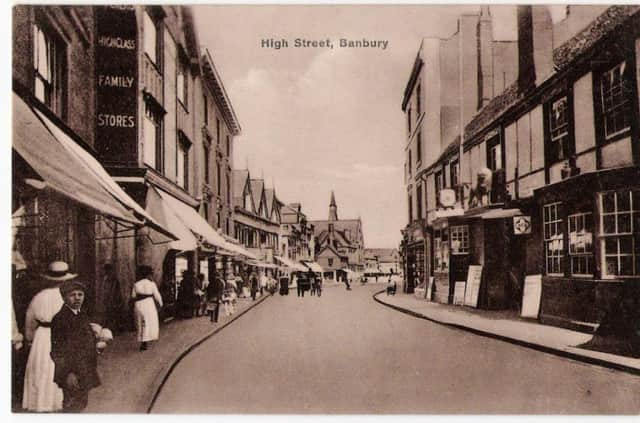Red Lion's impact


One of these is the Red Lion Inn, which was also highlighted in Bradshaw’s Railway Guide of the late 19th century.
In this visitors to Banbury were specifically directed to stay there whilst in the town and district.
Advertisement
Hide AdAdvertisement
Hide AdA local person who frequently dined there was the Revd. Risley, Vicar of Deddington in the mid-19th century.
Like-minded people were farmers who patronised the inn for market day lunches (market ordinaries) as well as doing business at the Corn Exchange.
It was held in the roomy yard and continued to be favoured after the creation of rival exchanges in the Market Place.
The papers and cuttings that have been saved under the Hurst label cover a diversity of reactions to the closure of the Red Lion in 1930 and its replacement by a Woolworths store a year later.
Advertisement
Hide AdAdvertisement
Hide AdAlthough the purchaser wanted to keep the model of the Red Lion agreement was reached with the Borough Surveyor Mr Sidney Hilton for the town’s retention of the Gateway.
In a letter Woolworths stated that they would treat the Gateway as a present to the town and that he was at liberty to remove it as soon as he liked.
Does anyone amongst my readers know what happened to it?
In a separate Hurst Collection paper the final market ordinary for farmers was described as ‘sadness mingled with harmony’.
A Captain Colman entertained the Thursday regulars. It was a meal with a difference as marked the occasion by arranging presentation of a silver inkstand to Ada Morton, the oldest member of the Red Lion’s staff.
Her service had spanned the years 1910-1930.
This was not the final farewell to the Red Lion.
Advertisement
Hide AdAdvertisement
Hide AdThat happened on a Saturday evening when people from the town crowded into the Smoke Room and we are reliably informed were rendered patriotic songs.
Interestingly not everyone viewed the facilities of the Red Lion through rosy spectacles.
Members of the local branch of the Farmers’ Union described their accommodation as a miserable space.
This was a dingy billiards room about which several club members drew attention to the dirt – stained windows and the little heaps of dirt sweepings in the corners.
Advertisement
Hide AdAdvertisement
Hide Ad‘Faded billiard tables and sordid lamp shades rendered the room depressingly cheerless’.
In ‘Victorian Banbury’ Barrie Trinder offers a more encouraging view of the Red Lion.
It was prominent amongst a number of 16th century timbered framed buildings.
Collectively these assumed great importance because of the loss of even earlier architectural treasures due to fires (especially that of 1628) and damage during the sieges of the 17th century Civil War.
Advertisement
Hide AdAdvertisement
Hide AdLike the White Lion (also in the High Street) the Red Lion became a prominent departure point for coaches.
A good example was the ‘Railway’, which in 1838 began a run to Denbigh Hall north of Bletchley.
The main outcome was a reduced journey time to London.
Another significant function as that of a large posting house.
Several post boys were a necessity.
On occasions as during the 1830s and 1840s the Red Lion was the venue for a grand annual ball for the nobility.
Advertisement
Hide AdAdvertisement
Hide AdLeading landed families of the area attended and needless to say townspeople were excluded.
The Red Lion was well-known for sales of land, property and contents of buildings.
Photographers often chose such occasions in order to take pictures from which to derive post cards of that part of the High Street.
A fortunately unusual occasion was that linked to the Parliamentary Election of 1859.
Advertisement
Hide AdAdvertisement
Hide AdThe contest was dominated by Bernhard Samuelson and Sir Charles Douglas.
The latter, who attracted Conservative support, hid in the Red Lion because of serious unrest.
In the end he was forced to escape through a rear window from whence he made his way to Aynho and caught a train to London.